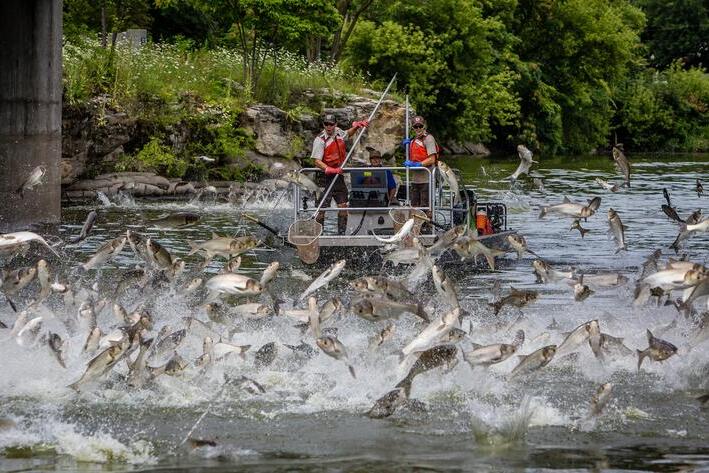Study: Invasive silver carp reduce movement in Chicago-area water

Invasive silver carp have been spreading throughout the Mississippi River Basin since their introduction a half-century ago. Yet, try as they might, the fish have not advanced beyond a particular stretch of the Illinois River north of Kankakee. Research from the University of Illinois Urbana-Champaign shows the fish are likely avoiding contaminants from the Chicago Area Waterway, which flows south before petering out around Kankakee.
A new study, published today in Scientific Reports, shows silver carp change their behavior and metabolism when introduced to water from the Illinois River north of Kankakee, representing Chicago-area water.
“When animals experience a stressor, sometimes they'll just get out of there. They think, ‘This is terrible, I'm leaving,’ and they scoot. But sometimes they reduce activity and hunker down. These animals think, ‘I'm just going to ride this out and see if conditions improve.’ When we put the carp in the Chicago water, that's what they did –- they reduced activity and stopped moving,” said study co-author Cory Suski, professor in the Department of Natural Resources and Environmental Sciences (NRES) in the College of Agricultural, Consumer and Environmental Sciences (ACES) at Illinois.
Suski and his colleagues from the University of Texas and the U.S. Geological Survey (USGS) trucked water from north of the Kankakee area to a USGS fish hatchery, where they compared silver carp behavior in water from the Chicago Area Waterway and from the laboratory.
“We’d drop fish in buckets and measure behavior using video cameras,” Suski said. “Fish in the lab water would explore, as if they were thinking, ‘Oh hey, I'm in a new bucket. What's over here?’ Over time, they’d get bored and stop moving, but carp in the Chicago area water slowed activity rates right away, suggesting an element of stress.”
Interestingly, although fish in the Chicago area water moved less, they were also burning more energy than carp in laboratory water. Suski says that shows the fish were likely working overtime to cope with contaminant exposure.
The new behavioral and metabolic findings are consistent with a 2019 study from Suski’s group showing wild silver carp sampled from north of Kankakee were turning on genes related to toxin removal, and turning off genes responsible for DNA repair and protective measures in their livers. Those patterns suggested that the fish were so busy detoxifying contaminants they sacrificed their own internal repair mechanisms.
Neither study identifies what specific contaminants the carp may be reacting to, but it’s clear from a USGS report that a number of Chicago-area contaminants drop off dramatically at the Kankakee-area site.
“Volatile organic compounds, pharmaceuticals, and a ton of other contaminants are all higher upstream, closer to Chicago,” Suski said. “There's a pretty big shift in contaminant concentrations right around this one pool of the Illinois River. Carp are spreading and becoming abundant everywhere else, except in this one spot. And it’s been that way for at least a decade.”
Amy Schneider, lead study author and former NRES graduate student, added, "By studying the physiology and behavior of invasive fish species like silver carp, researchers can continue to improve upon and develop methods of deterring these species."
Although contaminated water appears to be a pretty effective way to keep invasive carp out of the $7 billion Great Lakes fishery, no one is suggesting adding contaminants to prevent carp movement. In fact, Suski says recent efforts to clean the Chicago Area Waterway have been successful, as evidenced by healthier fish communities. But cleaning the water could have unintended consequences for silver carp.
“It’s good that Chicago area water quality is getting better, but the reality is that improving water quality might inadvertently remove the deterrent repelling invasive carp,” Suski said. “Continuing to work on this topic would be beneficial so we can understand why the population front has remained stable for so long and what might happen if the deterrent goes away.”
The article, “Silver carp experience metabolic and behavioral changes when exposed to water from the Chicago Area Waterway,” is published in Scientific Reports [DOI: 10.1038/s41598-024-71442-y]. The authors are Amy Schneider, A.J. Esbaugh, Aaron Cupp, and Cory Suski. The research was funded by the U.S. Geological Survey, the USDA National Institute of Food and Agriculture, and the Department of Natural Resources and Environmental Sciences in the College of Agricultural, Consumer and Environmental Sciences at Illinois